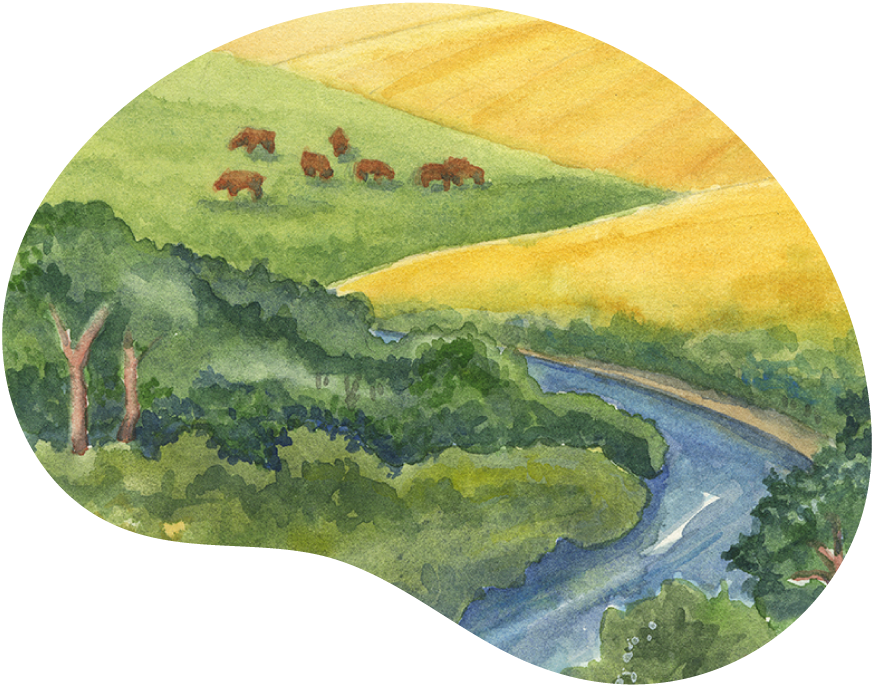Interactive Process Infographic
We developed this interactive guide of our process to help explain how Cows and Fish works with communities. This multimedia infographic will connect you to related information while you learn about the Cows and Fish approach.
Instructions:
- Press the play button below to begin.
- Click the elements of the process cycle to learn more about each step.
- Turn your sound on to hear the sounds of riparian areas as you navigate through the infographic.
- You can return to the main menu at anytime by pressing “X” or going to the “hamburger” icon in the top left of the infographic.
Awareness:
“Being informed helps people make good decisions!”
- Cows and Fish assists producers, resource managers, and others through workshops, field days, and hands-on learning to understand the health of riparian areas.
- Producers and resource managers spread the word to others about what works to manage riparian areas.
- Did you know? From 1992 to 2016, Cows and Fish has raised awareness about riparian areas through presentations, workshops, and field days involving 92,200 individuals.
- Creating a common language among individuals and communities – rural and urban – about the importance of well managed riparian areas.
Team Building
“Communication and trust are key to good relationships.”
- The partnership continues to provide opportunities for existing and new members (producers, community/watershed groups, municipalities, and resource managers) to become familiar with the technical knowledge available and begin to consider various management options.
- By bringing people that use and value riparian areas together to share knowledge about riparian areas, Cows and Fish helps groups find common goals: enhancing landscape health and productivity for everyone’s benefit.
Tool Building:
“Provide opportunities to learn a variety of riparian management alternatives.”
- ‘Tool-building’ involves putting useful technical and management information into the hands of landowners , agricultural producers and resource managers through written materials, presentations, on-ranch/farm demonstration sites, and workshops.
- ‘Tool-building’ includes working with landowners and land managers to devise practical solutions for riparian issues.
- Our management message has been formally evaluated through feedback from landowners, including agricultural producers. This information is incorporated into extension tools designed for a diversity of landowners and other resource managers.
- Practical examples of riparian management, such as local demonstration sites, provide a venue to customise, apply and document riparian grazing or other strategies that have been used elsewhere, and to provide a regionally applicable testing ground for such techniques. They are important ‘hands-on’ areas for agricultural producers and other landowners to share their experiences and insights. View some examples of demonstration sites we have been involved in. For more information on the value of demonstration sites and things to consider when setting up demonstration sites, please read our Demonstration Site fact sheet.
- We provide extension materials, assist with workshops and demonstration sites, and train individuals in riparian health assessment to create a “common language” and facilitate good management decisions.
Community-Based Action:
“Producers and communities drive the process.”
- The community determines the approach to riparian management in their watershed; Cows and Fish provides technical assistance, ‘tools’, and facilitates team building in the community.
- Community based action involves taking our message to landowners, agricultural producers, lakefront residents and others through local communities, stewardship groups, and organisations based on the decisions of the local landowner and community participants.
- A combination of presentations, extension material, workshops, riparian health assessments, local tours to demonstration sites, and ranch to watershed level planning is pursued to deal with local riparian issues.
Monitor and Evaluate:
“Did we make it?”
- Riparian monitoring provides better information to landowners and their communities so they can make better choices on land use and implement practice changes that enhance the long-term sustainability of their operations, rural communities and landscapes.
- By establishing baseline riparian health assessments in local watersheds, landowners and their communities are able to understand how healthy their watersheds and landscapes are. From this information, landowners and their communities develop action plans with resource managers to address specific riparian land use issues.
- Repeated monitoring in 3 to 5 year increments provides the answer to “Did we make it?” This long-term monitoring allows landowners and communities to evaluate their progress in addressing riparian land use issues, including tracking the success of demonstration activities.
- We believe through our experience, our process allows local communities to develop a long-term commitment to sustainable riparian management. Through the Cows and Fish Process, we endeavour to achieve the following:
- broad based partnership with a long-term vision
- commitment to action to make progress on riparian and watershed issues
- program exists through communities – meaning a local approach
- society goal is landscape health, not resource products alone
- create ecological literacy to speak a “common language”
- change rural and urban attitudes by demonstrating common interest
- share knowledge and wisdom between all members and supporters
Tips for success when working with communities can be found in our Getting Past the Talk fact sheet.




